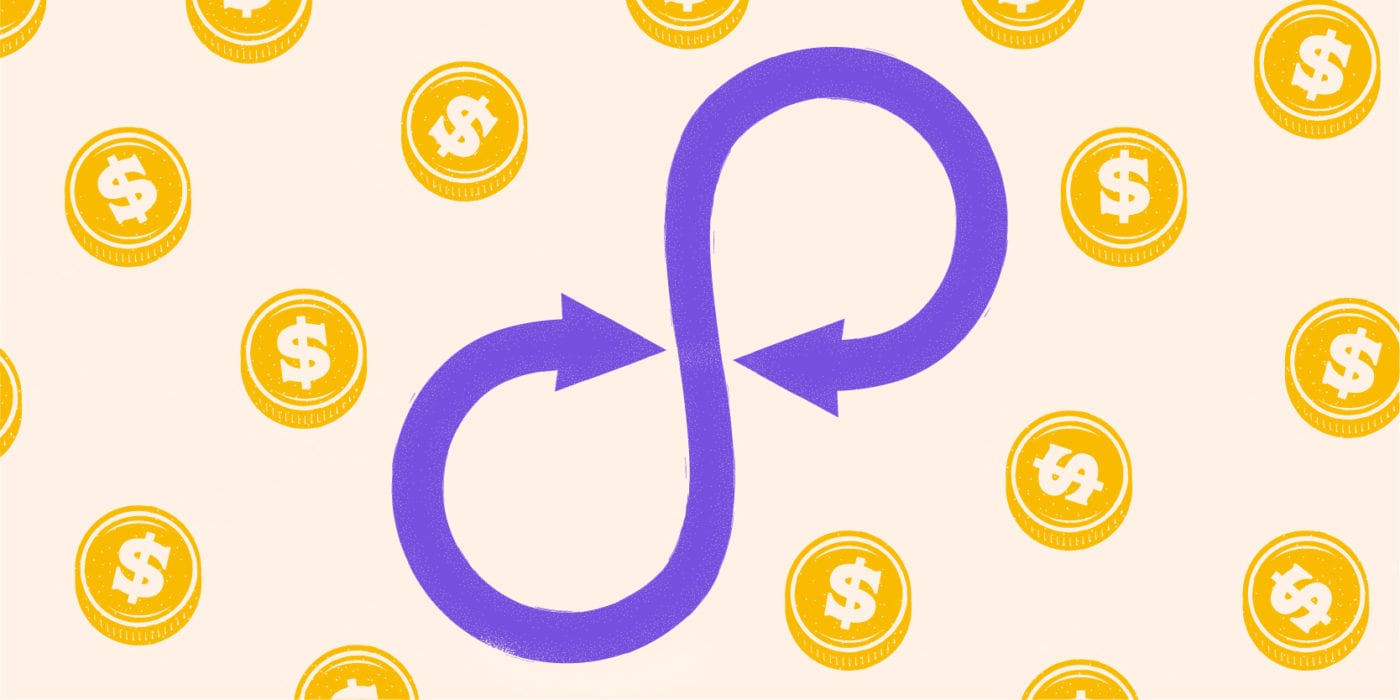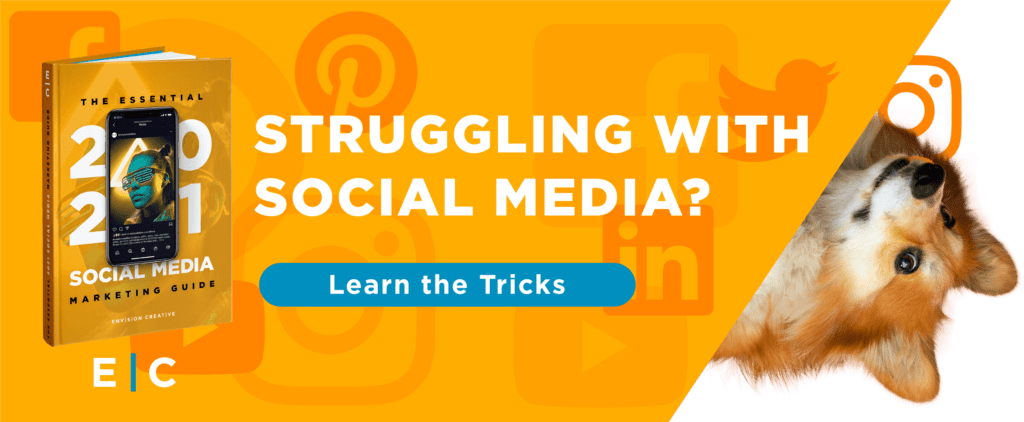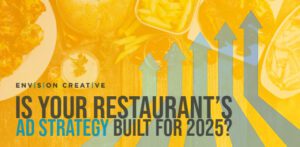Times of economic uncertainty have a tendency of stopping businesses in their tracks, looking for guidance on strategy and best practice. As our day-to-day has changed so much, so too have the needs of consumers across the country. These consumers are facing, as we all are, unprecedented times.
It’s important to take this time to establish a strategy for your business to help your messaging and services come across in the best possible way. The most important thing that businesses can do is to stay calm and remain strategic — with their online marketing strategies and especially their consumers.
According to Envision Creative’s Founder and CEO, David Smith:
“In times of economic crisis, many brand’s first instinct is to pull back on marketing and advertising, which is a natural reaction. While everyone is doing their best to be cautious, it’s important to remember that maintaining a presence through thoughtful, (and sensitive) marketing communication is even more crucial during these times.
While taking a broad approach to reduce or even eliminate your marketing initiatives might save funds in the short term, these actions may be at the cost of damaging your brand’s awareness with your ideal target audience during a time where top-of-mind awareness is critical.”
86% of consumers said that businesses who continued advertising efforts during the last recession, kept those businesses top-of-mind when making purchasing decisions. Try to understand what customers are thinking, how their behaviors have changed, and how to get in front of their concerns.
While it’s still unclear of the long-term impact COVID-19 will have on the economy, it’s important that your business is prepared. Generally speaking, we see consumers fall into 1 of 4 categories during times of economic change. Those categories are:
- “Slam-on-the-breaks” consumer: This consumer will end all non-essential buying. All essential buying will also be done based on the best possible price.
- “Pained-but-patient” consumer: This consumer will cut down to only buying essentials, but occasionally indulge in a treat. However, indulgences will be much smaller. This consumer will stock up on brand-favorites on sale but isn’t afraid to change brands for a better-priced product.
- “Comfortably-well-off” consumer: This consumer’s day-to-day buying habits have changed very little. They still purchase essentials in their preferred brand. However, luxuries are purchased less frequently and with more consideration.
- “Live-for-today” consumer: This consumer’s purchasing habit will stay almost totally the same. However, this consumer is less likely to spend money on purchases outside of their normal buying habits.
Identifying your target consumers and where they fall in regard to these 4 post-economic change identities, will allow you to attract, engage, convert, and retain customers, even in times of economic uncertainty.

Attract:
It’s important to consider two factors when you begin to strategize your marketing efforts during an economic downturn. You need to understand the needs of your current and potential customers. Depending on your business, those needs may have changed.
Conduct an internal meeting with your team to brainstorm ideas on a solution that’s the best step forward. Potentially send out a brief survey to further understand where their priorities are and what their top concerns are. Then build a solution around their responses, as well as layer into your acquisition strategy.
Making sure that your business is presented in a way that fulfills the current needs of your target personas is vital. Perhaps the majority of your target demographic falls within the “pained-but-patient” category of consumers. Then, you know that you have to present your product or business as an essential item in order for them to continue business with you.

It’s also important that even in the face of adjusted needs, your business continues to value the customers and relationships it already has. This may come in the form of a rewards system, discount for a particular purchase, or even a simple note from the Founder. Now’s the chance to delight your loyal customers. Valuing those relationships keeps your brand top-of-mind with consumers. It’s also an opportunity to show gratitude and empathy to your customers.
NOTE: Customers never completely “stop” buying – they’re just postponing their purchase due to financial apprehension. That’s why it’s more important for brands to continue communicating their value when the purchasing moment eventually hits.
Engage:
While you’re trying to figure out how to break through the noise, it’s vital that your brand remains authentic. This means showing that you care without coming across as having an agenda to sell them something. Use empathy to establish an emotional connection between the consumer and your business, which shows your business to be sensitive to the circumstances at hand.
For instance, reach out to your customers in an effort to connect and engage – not to acquire new sales, but rather ask, “What can we do for you? How can we help?” It’s vital that you understand the new challenges facing your customers so you may create valuable content to provide aid or solutions to those problems.

Providing timely and valuable content also allows your business to show empathy, rather than just speaking about it. Potentially provide your customers free assistance when filing for unemployment, a playlist to bring the brick and mortar atmosphere to their home, or even useful at home tips and tricks to keep themselves busy and entertained – share the content with your audience to show that you care.
This type of relevant, helpful content also lends itself easily to sharing on social platforms. Those shares provide a free, endorsed advertisement of your company to someone who might not have seen it otherwise.
Finally, consider opportunities to contribute to your community based on the global situation. 88% of consumers are more likely to buy products from companies that care about charitable causes.
Perhaps your brand can donate a portion of sales to a hospital or offer free/discounted meals to the front liners. By participating in causes, you can evoke compassion from customers, as well as attract new ones who are also engaged with the cause.
Convert:
To expect customers to convert in the same way they did prior to an economic change, when you’re in the middle of one, is a fool’s errand. Customer priorities, needs, and objections have changed, which means the buying process should reflect that. Your sales funnel will likely need to be changed.
As we saw with our buyer breakout in the introduction, even the most comfortable consumer is less likely to complete a purchase outside their traditional buying habits. This means customer acquisition is more difficult, which elongates the buying process. However, a few, simple changes to your business and offerings can help in finishing out that conversion.

Some changes your business can make include providing alternative options to include your target audience, and also the buying type that they fall into during economic change. The Harvard Business Review provides the example of PepsiCo offering a $5.99 twelve-pack for the pained-but-patient, but then also offering the $.99 two-liter for the slam-on-the-breaks consumer.
Also, if your store is selling something online, consider offering payment plans through services like Affirm. By offering a payment plan, you’re reducing the financial burden your customers will face in the short term. This is an easy way to boost your conversion rates, especially when many people are looking to reduce their cash spend.
In the end, don’t reduce the value of what you provide. Rather, reduce what you provide and how you provide it, but make it high value enough that your business becomes an essential cost for the consumer.
Retain:
During times of stress, consumers look to their trusted brands for slices of comfort, guidance, and clarity. The best way to calm anxiety and nerves is to communicate periodically to keep them informed.
Create a robust re-engagement program for your customers to make sure that you have the most up-to-date information on your converting customers, as well as build on the relationship your business has with that customer.
Company status emails from the CEO, paired with item emails to finish out a purchase the customer may have made previously, or a list of curated articles that relate to something they clicked on prior are all ways that your business can make sure that it keeps the customers you worked so hard to acquire.

It’s important to remember that when economic change happens, what we know about buyer behavior and expectations also changes. By evaluating your business often and acting quickly on data you’re able to acquire, you’ll be able to create a strategy that allows you to attract, engage, convert, and retain customers, even in the wake of an economic change.
-FINAL(01-00)-White&Blue-01.svg)





